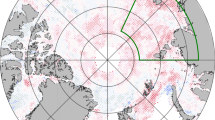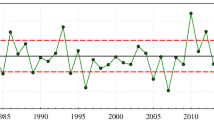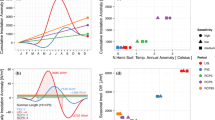Abstract
The response of low-latitude weather and climate to polar sea ice melt is not well understood. In this study, we run a suite of fully coupled simulations using the Community Earth System Model to investigate the effects of polar sea ice melt on Indian summer monsoon (ISM). In the coupled model simulation, the albedo of the sea ice is reduced in such a way that the increased absorption of the solar radiation would melt the sea ice. The effects of the Arctic and Antarctic sea ice melts on the ISM have been examined. The findings reveal that the combined melting of sea ice in the Arctic and Antarctic exerts a stronger influence on the ISM compared to the melting at a single pole. Specifically, the ISM exhibits a relatively weak sensitivity to the Arctic sea ice melt, while showing a stronger response to sea ice melt over the Antarctic and the combined melt over both poles. The response of summer monsoon to sea ice melt is characterized by a weakening of the circulation and a decrease in the continental precipitation, indicating an overall weakening of the monsoon system as a result of the polar sea ice melt. The intertropical convergence zone (ITCZ) and associated precipitation pattern shift equatorward in the sea ice melt experiments.














Similar content being viewed by others
Data Availability
Data is available from the authors
Code Availability
Codes are available from the authors
References
Blackport R, Kushner PJ (2016) The transient and equilibrium climate response to rapid summertime sea ice loss in CCSM4. J Clim 29(2):401–417
Briegleb, B.P. and Light, B. (2007), A delta-eddington multiple scattering parameterization for solar radiation in the sea ice component of the community climate system model, Technical Report NCAR/TN-472+STR, NCAR
Chandra V, Sandeep S, Suhas E, Subramanian AC (2022) Weakening of Indian summer monsoon synoptic activity in response to polar sea ice melt induced by albedo reduction in a climate model. Earth Space Sci 9:e2021EA002185
Chatterjee S, Ravichandran M, Murukesh N, Raj RP, Johannessen OM (2021) A possible relation between Arctic sea ice and late season Indian summer monsoon rainfall extremes. NPJ Clim Atmos Sci 4:36
Cohen J, Screen J, Furtado J, Barlow M, Whittleston D, Coumou D, Francis J, Dethloff K, Entekhabi D, Overland J, Jones J (2014) Recent Arctic amplification and extreme mid-latitude weather. Nat Geosci 7:627–637
Collins M, Knutti R, Arblaster J, Dufresne J-L, Fichefet T, Friedlingstein P, Gao X, Gutowski WJ, Johns T, Krinner G et al (2013) Long-term climate change: projections, commitments and irreversibility. ‘Climate Change 2013-The Physical Science Basis: Contribution of Working Group I to the Fifth Assessment Report of the Intergovernmental Panel on Climate Change. Cambridge University Press, Cambridge, United Kingdom and New York, NY, USA, pp 1029–1136
Comiso JC, Gersten RA, Stock LV, Turner J, Perez GJ, Cho K (2017) Positive trend in the Antarctic sea ice cover and associated changes in surface temperature. J Clim 30(6):2251–2267
Cvijanovic I, Santer BD, Bonfils C, Lucas DD, Chiang JCH, Zimmerman S (2017) Future loss of Arctic sea-ice cover could drive a substantial decrease in California’s rainfall. Nat Commun 8:1947
Deser C, Tomas RA, Sun L (2015) The role of ocean-atmosphere coupling in the zonal-mean atmospheric response to Arctic sea ice loss. J Clim 28(6):2168–2186
Deser C, Tomas R, Alexander M, Lawrence D (2010) The seasonal atmospheric response to projected Arctic sea ice loss in the late twenty-first century. J Clim 23(2):333–351
Ding Q, Schweiger A, L’Heureux M, Steig EJ, Battisti DS, Johnson NC, Blanchard-Wrigglesworth E, Po-Chedley S, Zhang Q, Harnos K et al (2018) Fingerprints of internal drivers of Arctic sea ice loss in observations and model simulations. Nat Geosci 12(1):28–33
Eayrs C, Li X, Raphael MN, Holland DM (2021) Rapid decline in Antarctic sea ice in recent years hints at future change. Nat Geosci 14(7):460–464
England M, Polvani L, Sun L (2018) Contrasting the Antarctic and Arctic atmospheric responses to projected sea ice loss in the late twenty-first century. J Clim 31(16):6353–6370
England M, Polvani L, Sun L, Deser C (2020) Tropical climate responses to projected Arctic and Antarctic sea-ice loss. Nat Geosci 13:275–281
Goswami BN, Xavier PK (2005) Enso control on the south Asian monsoon through the length of the rainy season. Geophys Res Lett 32:18
Guo D, Gao Y, Bethke I, Gong D, Johannessen OM, Wang H (2014) Mechanism on how the spring Arctic sea ice impacts the East Asian summer monsoon. Theor Appl Climatol 115:107–119
Hunke, E.C. and Lipscomb, W.H. (2008), Cice: the los alamos sea ice model user’s manual, version 4. los alamos national laboratory tech. rep, Technical report, LA-CC-06-012
Hunt KMR, Menon A (2020) The 2018 Kerala floods: a climate change perspective. Clim Dyn 54:2433–2446
Hurrell JW, Holland MM, Gent PR, Ghan S, Kay JE, Kushner PJ, Lamarque J-F, Large WG, Lawrence D, Lindsay K, Lipscomb WH, Long MC, Mahowald N, Marsh DR, Neale RB, Rasch P, Vavrus S, Vertenstein M, Bader D, Collins WD, Hack JJ, Kiehl J, Marshall S (2013) The community earth system model: A framework for collaborative research. Bull Am Meteorol Soc 94(9):1339–1360
Jahn A, Kay JE, Holland MM, Hall DM (2016) How predictable is the timing of a summer ice-free Arctic? Geophys Res Lett 43(17):9113–9120
Kay JE, Holland MM, Bitz CM, Blanchard-Wrigglesworth E, Gettelman A, Conley A, Bailey D (2012) The influence of local feedbacks and northward heat transport on the equilibrium Arctic climate response to increased greenhouse gas forcing. J Clim 25(16):5433–5450
Kennel CF, Yulaeva E (2020) Influence of Arctic sea-ice variability on pacific trade winds. Proc Natl Acad Sci 117(6):2824–2834
Krishnamurti TN, Krishnamurti R, Das S, Kumar V, Jayakumar A, Simon A (2015) A pathway connecting the monsoonal heating to the rapid Arctic ice melt. J Atmos Sci 72(1):5–34
Lawrence PJ, Feddema JJ, Bonan GB, Meehl GA, O’Neill BC, Oleson KW, Levis S, Lawrence DM, Kluzek E, Lindsay K et al (2012) Simulating the biogeochemical and biogeophysical impacts of transient land cover change and wood harvest in the community climate system model (ccsm4) from 1850 to 2100. J Clim 25(9):3071–3095
Liu J, Curry JA, Wang H, Song M, Horton RM (2012) Impact of declining Arctic sea ice on winter snowfall. Proc Natl Acad Sci 109(11):4074–4079
Liu J, Song M, Horton RM, Hu Y (2013) Reducing spread in climate model projections of a september ice-free Arctic. Proc Natl Acad Sci 110(31):12571–12576
Liu W, Fedorov AV (2019) Global impacts of Arctic sea ice loss mediated by the atlantic meridional overturning circulation. Geophys Res Lett 46(2):944–952
Mamalakis A, Randerson JT, Yu J-Y, Pritchard MS, Magnusdottir G, Smyth P, Levine PA, Yu S, Foufoula-Georgiou E (2021) Zonally contrasting shifts of the tropical rain belt in response to climate change. Nat Clim Change 11(2):143–151
McMonigal K, Larson S (2022) Enso explains the link between Indian ocean dipole and meridional ocean heat transport. Geophys Res Lett 49:e2021GL095796
Neale RB, Richter J, Park S, Lauritzen PH, Vavrus SJ, Rasch PJ, Zhang M (2013) The mean climate of the community atmosphere model (cam4) in forced sst and fully coupled experiments. J Clim 26(14):5150–5168
NSIDC (2022), National snow and ice data center’
Nuncio M, Chatterjee S, Satheesan K, Chenoli SN (2020) Temperature and precipitation during winter in nyÅlesund. Svalbard and possible tropical linkages. Tellus A 72(1):1–15
Oudar T, Sanchez-Gomez E, Chauvin F, Cattiaux J, Terray L, Cassou C (2017) Respective roles of direct ghg radiative forcing and induced Arctic sea ice loss on the northern hemisphere atmospheric circulation. Clim Dynam 49(11–12):3693–3713
Overland JE, Wang M (2013) When will the summer Arctic be nearly sea ice free? Geophys Res Lett 40(10):2097–2101
Peings Y, Magnusdottir G (2014) Response of the wintertime northern hemisphere atmospheric circulation to current and projected Arctic sea ice decline: A numerical study with cam5. J Clim 27(1):244–264
Prabhu A, Mahajan P, Khaladkar R (2012) Association of the Indian summer monsoon rainfall variability with the geophysical parameters over the Arctic region. Int J Climatol 32(13):2042–2050
Prabhu A, Mandke SK, Kripalani R, Pandithurai G (2021) Association between Antarctic sea ice. An observational study, Polar Science p, Pacific SST and the Indian summer monsoon, p 100746
Rantanen M, Karpechko AY, Lipponen A, Nordling K, Hyvärinen O, Ruosteenoja K, Vihma T, Laaksonen A (2022) The Arctic has warmed nearly four times faster than the globe since 1979. Commun Earth Environ 3(1):168
Rayner NA (2003) Global analyses of sea surface temperature, sea ice, and night marine air temperature since the late nineteenth century. J Geophys Res 108:14
Sandeep S, Ajayamohan RS, Boos WR, Sabin TP, Praveen V (2018) Decline and poleward shift in Indian summer monsoon synoptic activity in a warming climate. Proc Natl Acad Sci USA 115(11):2681–2686
Screen JA, Blackport R (2019) How robust is the atmospheric response to projected Arctic sea ice loss across climate models? Geophys Res Lett 46(20):11406–11415
Screen JA, Deser C, Smith DM, Xiangdong Zhang RB, Kushner PJ, Oudar T, McCusker KE, Sun L (2018) Consistency and discrepancy in the atmospheric response to Arctic sea-ice loss across climate models. Nat Geosci 11:155–163
Screen JA, Deser C, Sun L (2015) Reduced risk of north american cold extremes due to continued Arctic sea ice loss. Bull Am Meteorol Soc 96(9):1489–1503
Screen JA, Simmonds I, Deser C, Tomas R (2013) The atmospheric response to three decades of observed Arctic sea ice loss. J Clim 26(4):1230–1248
Sevellec F, Fedorov A, Liu W (2017) Arctic sea-ice decline weakens the Atlantic meridional overturning circulation. Nat Clim Change 7:604–610
Smith, R., Jones, P., Briegleb, B., Bryan, F., Danabasoglu, G., Dennis, J., Dukowicz, J., Eden, C., Fox-Kemper, B., Gent, P. et al. (2010), The parallel ocean program (pop) reference manual ocean component of the community climate system model (ccsm) and community earth system model (cesm), LAUR-01853 141, 1–140
Stroeve JC, Kattsov V, Barrett A, Serreze M, Pavlova T, Holland M, Meier WN (2012) Trends in Arctic sea ice extent from cmip5, cmip3 and observations. Geophys Res Lett. https://doi.org/10.1029/2012GL052676
Stroeve J, Notz D (2018) Changing state of Arctic sea ice across all seasons. Environ Res Lett 13(10):103001
Sun L, Alexander M, Deser C (2018) Evolution of the global coupled climate response to Arctic sea ice loss during 1990–2090 and its contribution to climate change. J Clim 31(19):7823–7843
Sun L, Deser C, Tomas RA (2015) Mechanisms of stratospheric and tropospheric circulation response to projected Arctic sea ice loss*. J Clim 28(19):7824–7845
Taylor KE, Stouffer RJ, Meehl GA (2012) An overview of CMIP5 and the experiment design. Bull Am Meteorol Soc 93(4):485–498
Tomas RA, Deser C, Sun L (2016) The role of ocean heat transport in the global climate response to projected Arctic sea ice loss. J Clim 29(19):6841–6859
Trenberth KE, Caron JM (2001) Estimates of meridional atmosphere and ocean heat transports. J Clim 14(16):3433–3443
Wallace, J.M. and Hobbs, P.V. (2006), Atmospheric science: an introductory survey, Vol.92, Elsevier
Wang K, Deser C, Sun L, Tomas RA (2018) Fast response of the tropics to an abrupt loss of Arctic sea ice via ocean dynamics. Geophys Res Lett 45(9):4264–4272
Xavier PK, Marzin C, Goswami BN (2007) An objective definition of the Indian summer monsoon season and a new perspective on the enso-monsoon relationship. Quar J R Meteorol Soc 133(624):749–764
Acknowledgements
S. Sandeep acknowledges the financial support by National Center for Polar and Ocean Research, Ministry of Earth Sciences (Government of India), under the PACER Outreach Programme (NCPOR/2019/PACER-POP/OS-04), to undertake this research. The model simulations are performed on the high performance computer at IIT Delhi.
Funding
S. Sandeep is funded by the Ministry of Earth Sciences (Government of India), through the grant NCPOR/2019/PACER-POP/OS-04.
Author information
Authors and Affiliations
Contributions
SS conceptualised and designed the study; VC designed and performed the model simulations, data analysis and plotted figures. Both authors interpreted the results and contributed to the writing of the paper.
Corresponding author
Ethics declarations
Conflict of interest
The authors do not have any Conflict of interest
Ethics approval
Not applicable
Consent to participate
Not applicable
Consent for publication
Not applicable
Rights and permissions
Springer Nature or its licensor (e.g. a society or other partner) holds exclusive rights to this article under a publishing agreement with the author(s) or other rightsholder(s); author self-archiving of the accepted manuscript version of this article is solely governed by the terms of such publishing agreement and applicable law.
About this article
Cite this article
Chandra, V., Sandeep, S. Relative roles of the Arctic and Antarctic sea ice melt on Indian summer monsoon. Clim Dyn (2024). https://doi.org/10.1007/s00382-024-07167-5
Received:
Accepted:
Published:
DOI: https://doi.org/10.1007/s00382-024-07167-5




